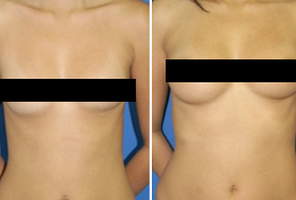Breast enlargement, or breast augmentation, can offer a more streamlined figure and more symmetrical breasts. Breast augmentation may also be an option for women seeking breast reconstruction after mastectomy or other loss of breast tissue. Augmentation is currently achieved via the insertion of breast implants — saline filled plastic bags — behind breast tissue or chest muscles. Silicone implants are currently FDA approved for breast augmentation in women over 22 years of age as of 2006, despite past controversies linking them to health risks. There are differences between saline and silicone that should be thoroughly discussed and understood prior to surgery.
 Breast augmentation can offer a breast size and shape which is more harmonious with overall body physique. Breast enlargement may be an option if breasts do not develop in a way that is satisfactory to the patient, if breast volume is not satisfactory, or if the shape of the breasts is not as symmetrical as one feels comfortable with. The goal of an aesthetic breast augmentation is to achieve a proportional and natural appearance.
Breast augmentation can offer a breast size and shape which is more harmonious with overall body physique. Breast enlargement may be an option if breasts do not develop in a way that is satisfactory to the patient, if breast volume is not satisfactory, or if the shape of the breasts is not as symmetrical as one feels comfortable with. The goal of an aesthetic breast augmentation is to achieve a proportional and natural appearance.
How is a Breast Augmentation performed?

Discussing the entire procedure from start to finish, as well as having an accurate understanding of what will or may occur and any risks involved is vital to promote satisfaction with the results of breast augmentation.
Breast augmentation generally begins with either general or local anesthesia. Each patient has unique needs and anesthesia should be discussed in detail with the surgeon to determine the appropriate type to be used. Once the patient is under some form of anesthesia, incisions are made to insert the implants, either through an inframammary incision, which is below the breast, a periareolar incision, which is an incision on the nipple, or a transaxillary incision, which is made in the crux of the arm, or armpit. There are other options which involve a navel incision and insertion as well. Each form of insertion has its own risks and likelihood of scarring which must be discussed in detail with the surgeon.
Implants may be inserted either in front of or behind the pectoral muscle which sits behind the breasts. Patients that opt to have the implants inserted behind this muscle generally encounter a lower risk of the body rejecting the implant as a foreign object, or capsular contracture. The exact position of the implants and where they should sit is unique to each patient, body type, and ought to be thoroughly discussed with the surgeon to ensure satisfaction and optimal recovery time. Once the implants are in place, the incisions are sealed with sutures, surgical tape, or some form of adhesive which seals the skin so that the surgery site can begin healing. Once the surgeon has sealed the incision sites, post-operative care begins.
What is the recovery period like after a Breast Augmentation?
Short term recovery depends in part on the type of anesthesia used. Recovery from general anesthesia may involve nausea and vomiting, shivering (called rigors) and disorientation. Recovery from local anesthesia is usually easier. Immediately after surgery, breasts will be sore and swollen. Bandages may be used to protect the surgery site and a drain may be inserted to help remove excess fluid build-up as the body heals.
Compression garments are used for support, to promote healing, and to help minimize swelling. A supportive bra must be worn twenty four hours a day for several weeks. Ice applied to the surgery site for the first two days to reduce bruising and swelling may be recommended. Drainage of fluid and crusting is normal. The cosmetic surgeon will discuss the proper and necessary care for the surgery site and every patient has unique needs.
Drains are usually removed at the first follow up visit a few days post-surgery. Depending on the kind of augmentation performed, pain can be significant and pain medications will be prescribed, as well as antibiotics. Swelling of the breasts and surrounding tissues is normal. Moving around the first day after surgery is possible yet most patients do not return to work for about a week or more. Individual healing varies which means that normal activities will resume at different times for each patient.
Activities such as lifting the arms above the head and heavy lifting should be avoided during the first few weeks. Strenuous activities, including sexual activities, should be avoided for several weeks to months, depending on how the healing progresses. Rushing the recovery process can actually slow healing time.
What risks are associated with Breast Augmentation and what preparation may be necessary?
There are multiple risks associated with breast augmentation. It is critical to understand these risks and to have realistic expectations regarding surgery outcome. Only through an in-depth discussion with a surgeon will the risks, benefits, and expected outcomes become clear.
Ceasing the ingestion of any and all over the counter, herbal, and prescription medications and vitamins that affect bleeding to decrease your risk of hematoma formation is vital to prepare the body for surgery. Patients should cease smoking for at least two weeks prior to surgery (even longer ideally), and smokers can face unique or elevated risks which should be thoroughly understood. Due to this, discussing lifestyle and any forms of consumption which can affect the body's ability to heal should be thoroughly discussed with the cosmetic surgeon.
Infection is always a risk of surgery. Antibiotics may be taken post-surgery to minimize risk of infection. Post-surgery, breasts may stretch and change in ways that are unattractive. Furthermore, after implant insertion, a scar tissue forms around the implant which can cause the breast to feel firmer than normal. In extreme cases, the scar formation can distort the breasts and the implants which may require removal of scar tissue.
Breast implants are not expected to last forever. For example, the implant can break, leading to deflation of the breast. The fluid from the implant may then be absorbed by the body and the implant will need to be replaced. Implants generally must be monitored and may need replacing every ten years or so, depending on the patient's individual case.
The presence of implants can affect breast cancer screening and make it more challenging to acquire an accurate reading of breast tissue. Sometimes, tests other than mammography are ordered (i.e. MRI or ultrasound) to better visualize breast tissue after augmentation.
Breast implants can lead to the development of autoimmune diseases. However, studies have revealed that this risk appears to be the same for women with breast implants and women without implants. There are risks of allergic reactions to implants, which are essentially a foreign object being placed into the body. This can result in the need for removal of the implants and reconstructive surgery.
Nipple necrosis leading to loss of the areola and/or nipple is a rare but serious side effect when incisions are made near the areola. Nipple necrosis is caused by impaired blood flow to the nipple and areola after surgery. The risk of this complication is higher in smokers.
Asymmetry of the size and shape of the breast is a common complication. It is impossible to create perfect symmetry and small differences should be expected.
Inability to breast feed post-surgery can occur but many of the procedures used today usually do not affect breast feeding. The risk varies with the type of surgery.
Breast augmentation can lead to changes in skin sensitivity because removal of the skin involves cutting through nerves that influence sensation. Loss of sensation is usually minimal and returns over the course of a few months.
Fluid accumulation in the breast, called a seroma, can occur after breast augmentation. Seromas can be drained and usually resolve within a few weeks. Accumulation of blood in the skin after surgery is called a hematoma and usually must be removed surgically. Hematomas can increase the risk of infection and may increase scarring.
Scarring occurs with any surgery and final scar appearance cannot be predicted. Scars can vary from a nearly invisible line to a large, raised, discolored scar depending on the body's reaction to healing. Unwanted scars can be treated through medical or surgical intervention.
This list is not exhaustive and the risks and potential side effects associated with breast augmentation ought to be treated seriously and in-depth discussion with a professional cosmetic surgeon is necessary to fully understand what to expect.
How much does Breast Augmentation generally cost?
Breast augmentation costs vary based on location, the cosmetic surgeon, demand, the time and effort required during the procedure, as well as what's required during the procedure from start to finish (lab fees, anesthesiologist, hospital stay fee, etc.)
Generally, spending anywhere from $4,000-$10,000 can be expected. The exact cost of your procedure is of course highly variable and based on your specific situation. To consult with a cosmetic surgeon and discuss breast augmentation and the overall cost, find a surgeon in your area that is right for you.
Breast Augmentation Related Articles
Featured Cities:
Scottsdale | Beverly Hills | Santa Ana | Cherry Hill | Houston
Disclaimer: This information is intended only as an introduction to this procedure. This information should not be used to determine whether you will have the procedure performed nor does it guarantee results of your elective surgery. Further details regarding surgical standards and procedures should be discussed with your physician.
By OnlineSurgery Staff
Updated: November 11, 2008

